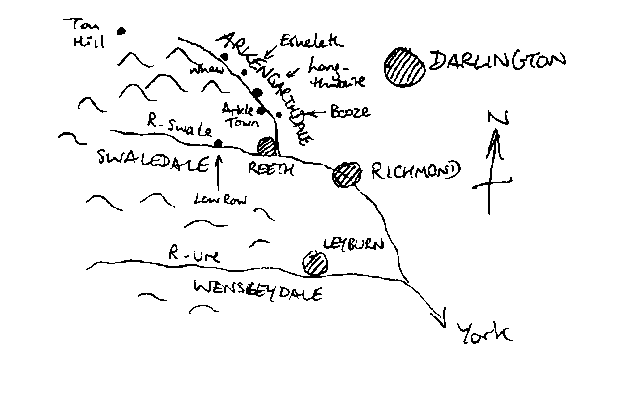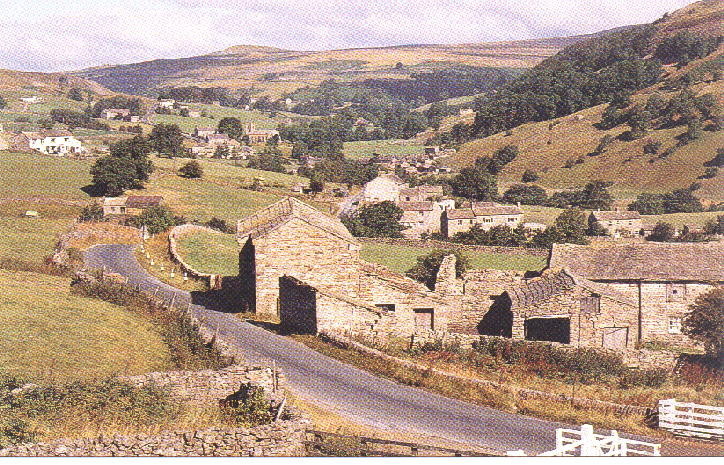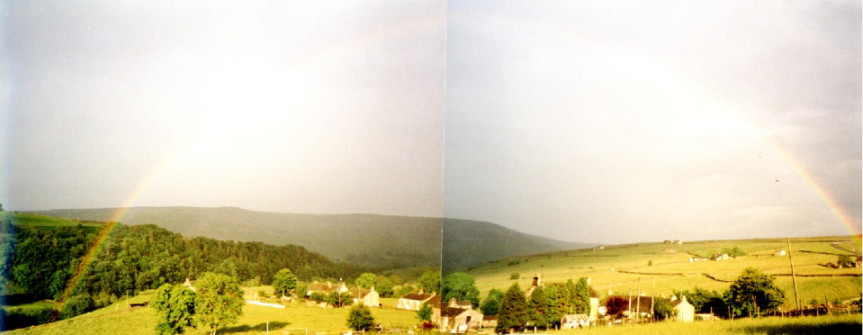
I am not originally from the Yorkshire Dales but my family moved there in November 1990, and I followed a year later, living in the pretty isolated valley of Arkengarthdale for two years full time before moving to Leeds and on and off since. I now consider both places to be home and ain't going back South if I can help it!! This page is therefore my feeble attempt to introduce you to the beauty of my home.
| Arkengarthdale is the most northerly of the Yorkshire Dales. It is a tributary of Swaledale, the valley of the River Swale, which joins the Ure (Wensleydale's river) and the Nidd to form the Ouse. This flows through York and ultimately into the sea through the Humber Estuary. The Swale is said to be the fastest-flowing river in England - it's certainly amongst the most beautiful in its upper reaches. The no-expense-spared and completely not-to-scale map on the right shows its location. Arkengarthdale's river is the Arkle Beck, and the whole thing is said to be named after Arkil, a Viking chieftain in the 11th century or thereabouts. |  |
Because of its tiny population (no more than 200 in its 10-mile length), Arkengarthdale lacks services and in a lot of ways can be considered as a part of Swaledale. But it is far less crowded and unspoilt, and has a character all its own. You can run your mouse pointer over the photograph below and click on its various features to get more information about them.

This is the White House, and the reasons behind the name should be fairly obvious. Ancestral home of Clan Whitworth since November 1990. It is a converted farmhouse and currently run as a bed and breakfast. For more information click here. The story goes that it is painted white because it was used as a marker in times gone by for people coming over the hills into the dale, but personally I suspect it was just painted white because it looks much nicer that way. It isn't as big as it looks! But it certainly dominates the hamlet of Arkle Town below.
This photo was taken from the front garden of the house. I know the lighting looks a little strange, but we'd just had a thunderstorm: hence the rainbow.

This is the road from Reeth, largest village in Swaledale, about three and a half miles away over the moors. Reeth is another beautiful spot but far, far too crowded at times. If you've ever seen the film (not the TV series) of All Creatures Great and Small, you'll have seen Reeth: the vet's surgery was there. (For a little comment about Mr. James Herriot, see below.) My father runs a clockmaking and repair workshop in the village: click here to visit his site.
The hamlet of Arkle Town, named after the eponymous Arkil, population about twenty-five, and that includes dogs. There once was a church here, but that's now gone, and only a few forlorn gravestones remain in a field to mark it. Now there's nothing here bar a few houses.
| Langthwaite, the pulsing metropolis of Arkengarthdale. Whatever happens in the dale, happens here. Or at the CB. One of the world's more picturesque villages - as you can see in this photo - there's another Herriot link: in the opening credits of the TV show, they are seen driving their car out over the bridge that crosses the Arkle Beck and links Langthwaite to the rest of the world. Stubbs' shop is still there, and looks exactly the same as it did when they filmed it, and indeed as it probably did when Mr. Herriot was practising. There's a cosy, if rather strange, pub called the Red Lion as well. I saw the Millennium out here. |  |
St. Mary's, Arkengarthdale's church. My sister Vicki got married here in September 1996. There is a tradition in the Dales that during the wedding the churchyard gates are locked and the local children gather outside, only unlocking the gates and freeing the wedding party after money and treats are thrown over the gate. This duly took place: the kids had enough nous to use their coats to cover a storm grating outside the gate to stop the treats falling down it!
You can't really see it but this is the road over the tops to Low Row in Swaledale, about three miles away. Again, one bit of it may be rather familiar: the "watersplash" from the opening sequence of ACGAS, which lies about halfway along. I used to drive this road almost every day when I worked at Low Row's Punch Bowl Inn. We won't mention the time in July 1997 when I and the car ended up in a beck just off it.
 | The CB hotel, Arkengarthdale's major social centre. Great beer, great food, and a refreshing change from a lot of "rustic" local pubs, done out as it is in rather tasteful stripped pine. Highly recommended. Contact them: their telephone number is 01748 884567. The photo on the left was taken not far from the CB. |
This road winds up into the hills and onto the moors, becoming bleaker and bleaker until at one point, about eight miles from where this photo is taken, you look to the right and see the bleakest view you'll see in these islands, I think - Sleightholme Moss, a flat, blank, empty wasteland of a place. Keep going though, because two miles later you come to one of the more extraordinary pubs in Britain, the Tan Hill, at 1,745 feet above sea level, the highest in the country. Words cannot describe this place. See it - or walk the Pennine Way, which effectively passes through its bar.
This is called Kitley Hill. Er... it's a hill. You can climb it. And it's called Kitley. (Sorry, not much more to say here.)
Hidden amongst these trees is the hamlet of Eskeleth. Like the other hamlets - Arkle Town, Whaw, Booze (honestly) - this name is pure Old Norse. It were the Vikings wot came here and settled, not these namby-pamby southern invaders called the Saxons. They came later!!
This road heads over hill and moor into County Durham and eventually down to the town of Barnard Castle, a pleasant enough place with the eponymous castle and the slightly famous Bowes Museum to while away your time.

Just a small word about a certain vet. The books of Alf Wight - better known as James Herriot - who wrote about his experiences as a vet based in Thirsk before, during and after world war II have undoubtedly done a lot of good to this area in terms of maintaining its economy thanks to the tourism they promote. To be more accurate, the TV series based upon them, starring Christopher Timothy, Peter Davison and Robert Hardy and filmed around Swaledale, Arkengarthdale and Wensleydale in the early 1980s have. (If you're interested, the village of Askrigg in Wensleydale was "Darrowby".) Personally, however, I'm not so sure. This is no film set. It's a living, breathing part of the world. Contrast it as well with the Lake District which is swamped by tourists and you can easily drive across the whole district with the impression that no-one actually lives there, every building is a B & B or an outdoor activity centre or a holiday cottage. Not in the Dales. We envisage our rural idylls as perfect, somehow out of time, a theme park to which we can retreat and forget the pressures of the 20th (or even 21st) century. But if you should go to Arkengarthdale, or anywhere in the Dales, please remember that it's no theme park. The local people who are staffing your hotel or blocking your way with their tractors are not there as local colour, it's their home. Life in places like this isn't perfect. But then again - it ain't bad either....